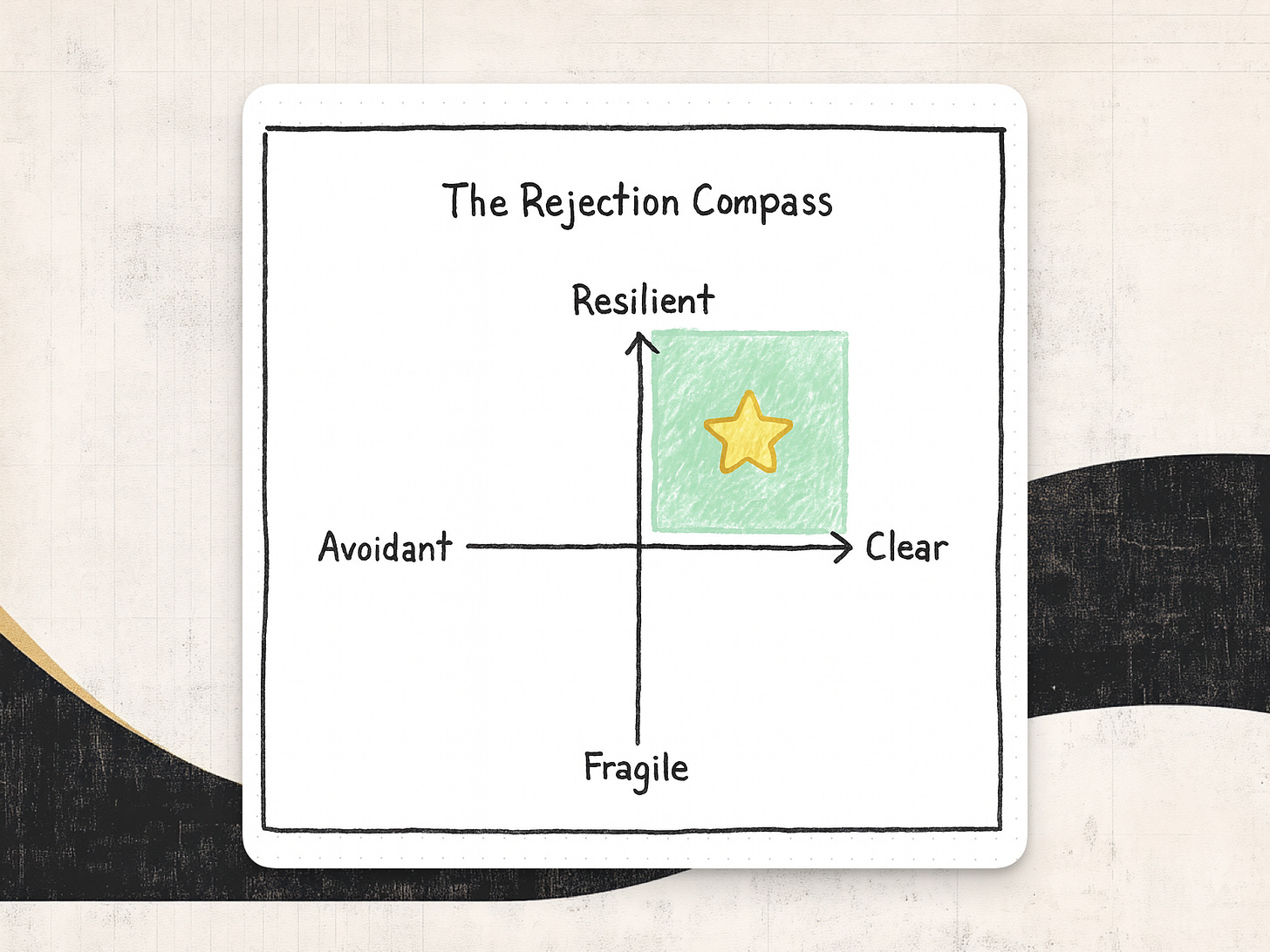The School of Rejection
Don't fear rejection. Become fluent in it.
Welcome to Unknown Arts — I’m Patrick, your field guide to the creative frontier. Join thousands of builders around the world navigating what’s next.
You don’t need to fear rejection. You need to become fluent in it.
I’m 35, and I’m only now getting good at handling rejection. Not just hearing “no”, but saying it. Letting people down clearly and compassionately. Choosing what’s right for me, even when it disappoints someone else.
It’s rarely taught as a skill. But it’s one you have to learn if you’re trying to forge your own path.
For a long time, I avoided both sides. I held back from asking for things I wanted because I feared the potential rejection. And I dodged decisions, delaying hard conversations because I didn’t want to be the one doing the rejecting. I convinced myself I was sparing someone pain. But really, I was just avoiding my own discomfort.
Rejection is a skill
Here’s what I’ve learned: rejection isn’t failure or conflict. It’s just an inevitable function of trying to move forward honestly.
More importantly, it’s a skill. One that can be developed through practice.
There are two sides to rejection and you can train both:
Taking a “no” without falling apart
Delivering a “no” without disappearing
Think of rejection as a compass with two axes: how you take it (resilient vs. fragile) and how you give it (clear vs. avoidant).
You want to live in the resilient + clear quadrant. At least, I do.
Some professions force you to master one side:
Taking rejection becomes second nature when your goals are clearly on the other side of mountains of “no”:
Founders pitching to find early customers
Actors auditioning hundreds of times to get cast
Comics testing material that might bomb
They hear “no” constantly and learn to move through it, building resilience by necessity.
Giving rejection becomes a core skill when protecting what matters requires clear boundaries:
Investors rejecting pitches with clarity
Directors casting with honesty
Creative leads protecting the work by saying “not yet”
When done right, rejection is an act of respect. It’s not personal, it sets a clear, present boundary. And that clear guidance, while tough to accept with grace, is often exactly what the moment calls for. It’s a form of leadership that invites people to redirect their energy rather than waste it.
Building fluency
Being graceful and clear in your handling of rejection is easier to say than do. It never gets easy. The discomfort doesn’t vanish, but your capacity to move through it develops.
Each time you practice, you build evidence for yourself. You ask for something and hear “no” and realize you’re still standing. You deliver a clear “no” and see that honesty doesn’t destroy relationships—often it strengthens them. That evidence compounds. It doesn’t eliminate the discomfort, but it makes you more willing to move through it next time.
Chris Dixon wrote that “if you aren’t getting rejected on a daily basis, your goals aren’t ambitious enough.” Daily is a bit strong for my taste, but the principle is sound: if you’re never facing rejection, you’re probably not pushing hard enough on either side.
The compounding effect
Here’s what surprises me about developing this skill: it doesn’t just make rejection easier. It increases your agency.
When you can take rejection well, you ask for more. You pursue opportunities you would have talked yourself out of. When you can give rejection clearly, you protect your time and energy for what matters most. You help others redirect faster rather than leaving them in limbo.
Both sides work together. And the better you get at navigating rejection, the more ambitious you can be about building the life and work you actually want.
Until next time,
🎯 Try this
Pick one practice from each axis:
On taking rejection: Where have you been holding back out of fear of hearing “no”? Ask anyway. Take a big swing.
On giving rejection: Where have you been softening a “no” that needs to be said? Rip the band-aid off and say it clearly.
There’s valuable guidance waiting in both.
📚 Go deeper
What I Learned From 100 Days of Rejection – Jia Jiang – How an entrepreneur conquered his fear of rejection by intentionally seeking it out every day, turning “no” into opportunities for growth.
Seth Godin on Overcoming Rejection – Tim Ferriss Show – A conversation about choosing your attitude, dealing with fear of failure, and pursuing meaning over comfort.
From Rejection to Resilience – Sources of Insight – Five inspiring stories of how rejection became the catalyst for extraordinary success, from Rocky to Harry Potter.
Find this valuable? Share it on X or LinkedIn and tag me (@itspatmorgan).
Not subscribed yet? Get my essays directly — 7k+ already do.









👏 Great post Pat! You know I love a good 2x2.
Almost every "no" (if given well) is an opportunity to ask "what about this is true?" and hopefully grow.